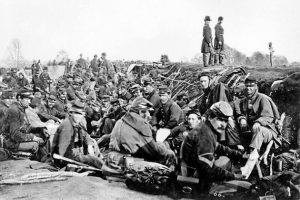FPS – Cast of Hundreds
 In a summary, a single sentence can radically alter the length of a story. In writing comics, length is a tightly controlled commodity, so we redraft the story as an outline. The outline dictates the story beats, which scenes will appear in which order, and how many pages we have to accomplish that scene. Despite the principal purpose being control, our outlines tend to be a loose shorthand.
In a summary, a single sentence can radically alter the length of a story. In writing comics, length is a tightly controlled commodity, so we redraft the story as an outline. The outline dictates the story beats, which scenes will appear in which order, and how many pages we have to accomplish that scene. Despite the principal purpose being control, our outlines tend to be a loose shorthand.
“Page 20 -21: Sewing circle for Abby, parlor game, learn of transport on White river, Abby as spy.”
This line dictates one left and one right page for a scene where Abby and a few friends gossip during a typical 19th century social gathering, a piece of information critical to the plot is passed along, and we discover that Abby is a spy. Seems like a lot for two pages, but it’s really not. Page 20 will set the stage for conversation, and all the story points are single lines of dialog on page 21.
The words “sewing circle for Abby” seem innocuous, but Abby didn’t exist before this line. She’s the wife of a central character, so of course she needed to exist, but she had never been mentioned directly, never given anything to do in the story; she didn’t even have a name. One line of sentence fragments and she’s a spy with critical impact on events surrounding the development of flying boats.
At every stage of writing a script, we maintain a cast sheet, listing all of the characters who will appear in the final story. Our cast sheet for a single issue of a comic included about 15 named characters on average. For each, we list: the shorthand name used in the script; the full name or description; and some identifying characteristics like build, costume, hair, complete origin story, or facial features.
“Sewing circle” two words that mean five more characters added to the “Master Cast Sheet” for Flying Pirate Ships! They could have been nameless women chattering about. But, in the moments since her spontaneous existence, Abby has known them for years. She knows their names — she would use their names. Which means we have to know their names, too.

Every one of these people has a name, and years of story before this moment, and something they did right after it.
As daunting as it is to suddenly create five women, Flying Pirate Ships! is a big story spanning two planets full of people. Obviously we’re not going to bother with knowing the name of every person on two planets — we’re crazy, not insane — but Britannia has a crew — 50 men who work together to run the ship.
50 Men we’re going to see a lot of. 50 men who know each others names.
From the Master Cast Sheet: “The hero ship, Britannia, is crewed by fifty named characters. … [T]here are no faceless/nameless/red shirts on Britannia. …”
They might not all get speaking roles, but they all have first and last names. They each have a job assignment on the ship.
We’re two outlines in, and the Master Cast Sheet currently has 120 named characters.